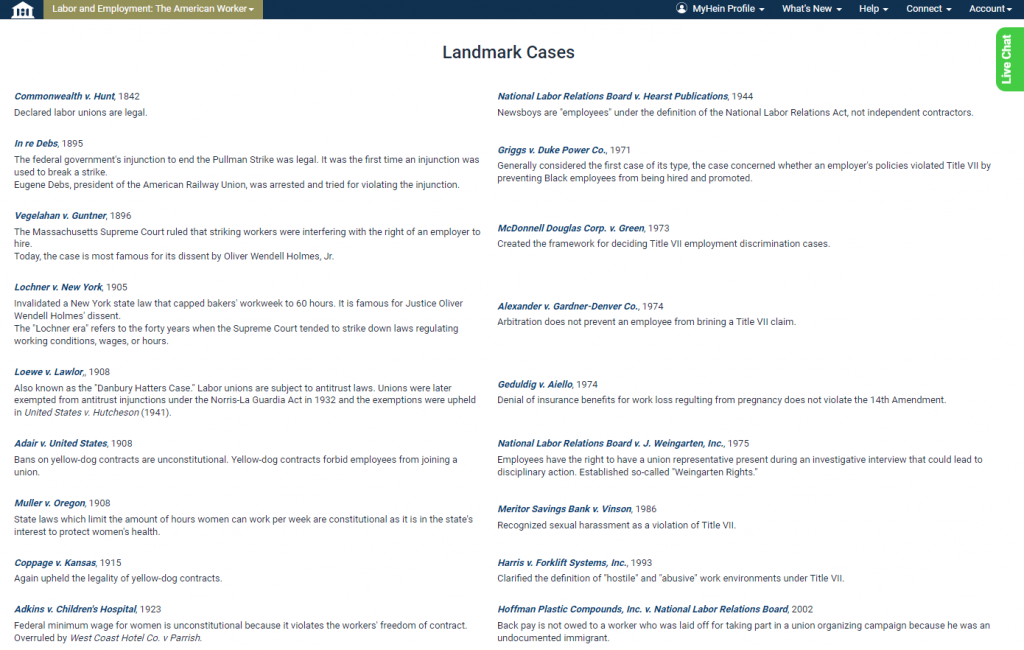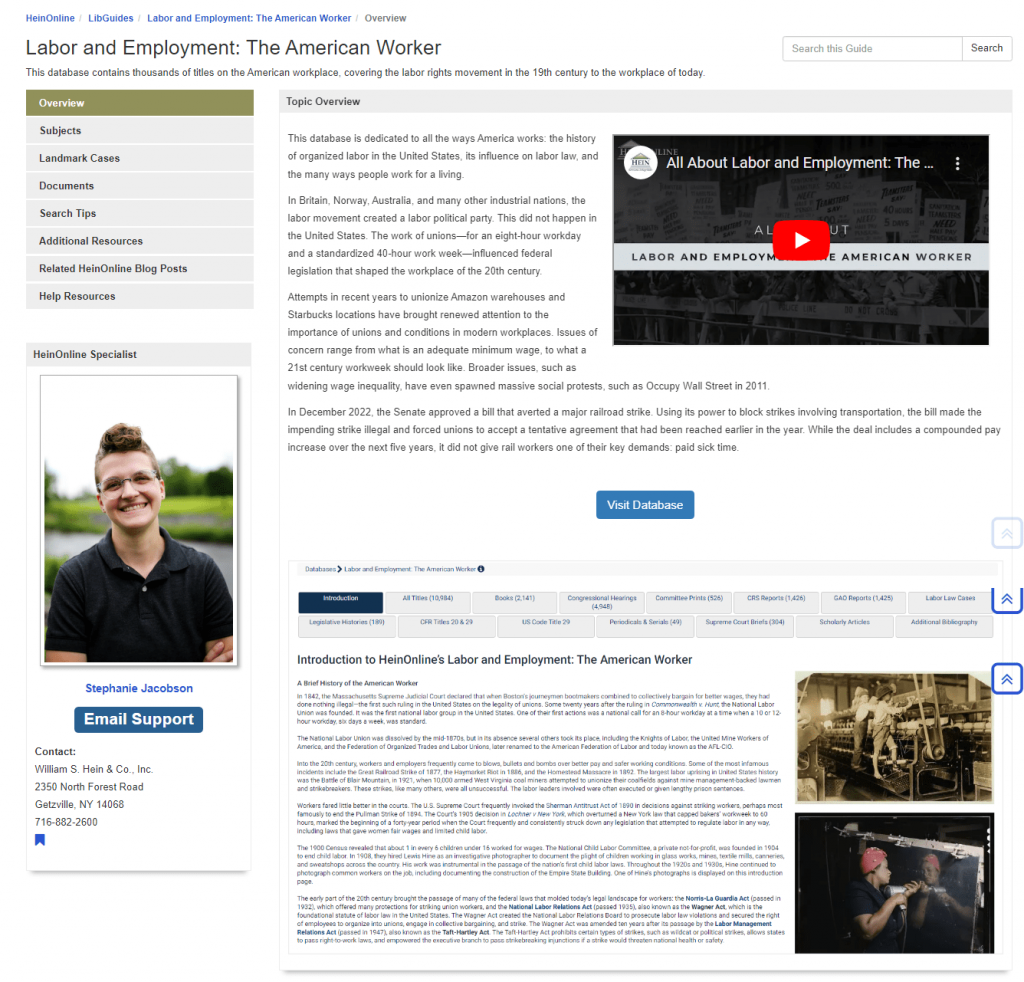Explore the plight and successes of America’s working class with HeinOnline’s newest editorialized collection of more than 10,000 titles that illuminate the history of labor conditions and employment law in the United States. Labor and Employment: The American Worker is an extensive collection that allows users to explore all of the cases, legislation, scholarly articles, and much more related to the workplace in the United States. And the best part is we’ve made it easy for you to add to your subscription—this collection is available for an affordable, one-time payment. Check out the video below and keep reading to learn more about this hard-working database.
About the Database
From 1866, when the first national labor union was formed, to today, when employees still struggle with poor wages, lack of benefits, and high degrees of job dissatisfaction in the wake of the Covid-19 pandemic, the American workplace has always been rife with conflict between employees and employers. With this newest database, users can explore legislative histories, Supreme Court case briefs, accounts of historical labor riots, current reports on working conditions, and so much more in order to illuminate the rich history and current landscape of America’s workforce.
Get a unique perspective with our chart of landmark court cases related to labor and employment law, including links to the full text, synopsis, and explanations of each case’s significance in both labor jurisprudence and history. From state court cases that impacted the entire country, to decisions made in the U.S. Supreme Court, this database covers cases from 1842 to 2018.
In addition to over 10,000 subject-coded titles, our editors have carefully curated hundreds of expertly written scholarly articles on topics like employment protections, labor contracts, collective bargaining, and more, all ranging from 1904 to present and with new articles added each month.
For those looking to further their research, our editors have even selected over 200 highly recommended titles. While full text of these titles is not available in the database, each title is linked to its WorldCat entry to help users locate the book in a nearby library.

Featured Content

Landmark Cases
Unique to this database is a chart of 24 landmark federal and state court cases related to labor and employment law, each including date and a brief synopsis and linking directly to the original full-text decision.

Books
Browse thousands of books ranging in date from the early 1900s to present day. Find accounts of the Haymarket Riot and other famous labor uprisings, treatises decrying communism, histories of unions, and more.

Government Documents
HeinOnline editors have hand-selected committee prints and congressional hearings that provide insight into the federal government’s stances on the state of labor and employment, as well as nearly 3,000 relevant Congressional Research Service and Government Accountability Office reports.

Legislation & Supreme Court Briefs
This collection includes nearly 200 legislative histories that illustrate the progression of essential labor-related laws, as well as relevant sections of the CFR on labor and employment (CFR Title 20: Employees Benefits, CFR Title 29: Labor and US Code Title 29: Labor) and more than 300 Supreme Court briefs.

Scholarly Articles & Bibliography
Researchers can peruse hundreds of articles selected on employment discrimination, wrongful termination, collective bargaining, how the New Deal shaped labor law, right-to-work laws, labor disputes in major league sports, and more. Additionally, our editors have created a bibliography of other relevant books, including links to WorldCat entries.

Serials & Periodicals
Browse serials and periodicals dedicated to labor and employment matters, including Annual Report of the National Labor Relations Board, Decisions of the Federal Labor Relations Authority, Employee Rights and Employment Policy Journal, and Occupational Outlook Handbook.
Includes Extensive Content on Rail Working Conditions
In light of the environmental and public health disaster in East Palestine, OH, stemming from the recent derailment of a Norfolk Southern freight train carrying hazardous materials, researchers will find a variety of current and historical content in this database regarding rail workers and railroad working conditions over the past century. Example titles include:
- 4v. Railway Labor Act of 1926: A Legislative History (Michael H. Campbell & Edward C. Brewer III eds.) (1988)
- Rail safety : hearing before the Government Activities and Transportation Subcommittee of the Committee on Government Operations, House of Representatives, One Hundred Second Congress, second session, January 13, 1992.
- President Forms Emergency Board to Resolve Rail Labor Dispute (IN11966)
- Employment in Rail Transportation Heads Downhill between November 2018 and December 2020
- Fatigue in the Rail Industry: Hearings before the Subcommittee on Railroads, Pipelines, and Hazardous Materials of the Committee on Transportation and Infrastructure, House of Representatives, One Hundred Tenth Congress, First Session
Subject-Coded Content for Simplified Searching
To help users navigate the content spanning this extensive database, HeinOnline editors have created 18 new subjects:
Slave labor formed an integral part of America’s early economy and labor force. Today, incarcerated workers repair roads, fight wildfires, manufacture furniture, license plates, and more, often with paltry or no pay and without the workplace protections given to their non-incarcerated peers.
Workers expect to receive more than just a paycheck for their hard work and time, in the form of paid time off, employer-sponsored healthcare, paid sick time, and more. Learn about common benefits and the inequality experienced between workers in receiving these benefits.
This subject presents titles on creating a more equitable workplace for women, minorities, the elderly, and persons with disabilities, and the workplace challenges faced by the marginalized.
Foreign-born workers make up approximately 17% of the total workforce in the United States and are more likely to be employed in agriculture, construction, and service industries. Learn about the vital role immigrant workers play in the economy.
Under this subject, users can find titles on specific strikes and work stoppages from history as well as titles dealing with these subjects generally.
Users can find titles relating to specific labor laws that have been passed and proposed laws. These laws can affect hiring, firing, benefits, workplace protections, and more.
The “labor market” refers to supply and demand for labor. It includes people looking for jobs as well as the type of employee that employers want.
Labor unions are groups of employees who work together to protect and advance their common interests, such as higher wages, benefits, and safer working conditions. Learn about specific unions as well as how the work of unions help advance all workers.
This subject covers the relationship between employees and employers, the relationship between employees, and how a workplace functions.
The federal minimum wage was created in 1938 by the Fair Labor Standard Act. Learn about the law that established it, arguments over what the federal minimum wage should be, and efforts to raise the minimum wage with this subject.
When workers are injured on the job, they have certain legal rights. Certain professions are also more inherently dangerous than others, exposing workers to conditions that can result in life-threatening diseases. Learn how injured workers are compensated.
Today, employees covered under the Fair Labor Standard Act (passed in 1938) must receive overtime pay for hours worked over 40 in a workweek at a rate of time and one-half their regular pay rate. Learn about overtime pay with this subject.
Pensions, or funds to care for a person when they retire from working, are as old as antiquity. In the United States, public pensions were offered to Revolutionary War and Civil War veterans and their survivors. Modern employer pension plans boomed in popularity during and after World War II, with defined benefit plans becoming the more popular retirement plan in the 1980s. Invest in how workers prepare to live after their working years with this subject.
Public sector employees work for the government, either federal, state, or local. It is taxpayer funded and service driven. Examples of public sector employees include public school teachers, firefighters, police officers, public transportation workers, and government workers. Approximately 14% of the U.S. workforce is employed in the public sector, or 20 million people.
What goods the United States trades with and imports from other countries drives the manufacturing base of the economy—and in turn affects workers and their wages. In turn, a healthy economy can support workers with good jobs and high wages. Learn about how trade and the broader economy impacts all workers with this subject.
Eligible workers who are out of a job are entitled to benefits that vary from state to state. The Covid-19 pandemic saw unprecedented numbers of workers eligible for historical unemployment assistance. Learn about the history and current state of these benefits, as well as what wider unemployment trends may signal about the wider workforce.
Workers trade their time for a paycheck. Learn about how wages are paid, calculated, and have changed over time.
Various laws exist to make every workplace safe and welcoming for all. These protections include safeguarding workers’ physical and emotional well-being, insuring they are safe from injury and harassment.
Labor and Employment LibGuide
This database’s dedicated LibGuide provides researchers with tips for browsing and searching the variety of content within this database, as well as additional resources, subject scope notes, and much more!

Research Won’t Feel Like Work with This Database
And it’s easy to add it to your institution’s HeinOnline subscription, too! Contact our Sales and Marketing team today to receive a quote for a one-time payment today.



